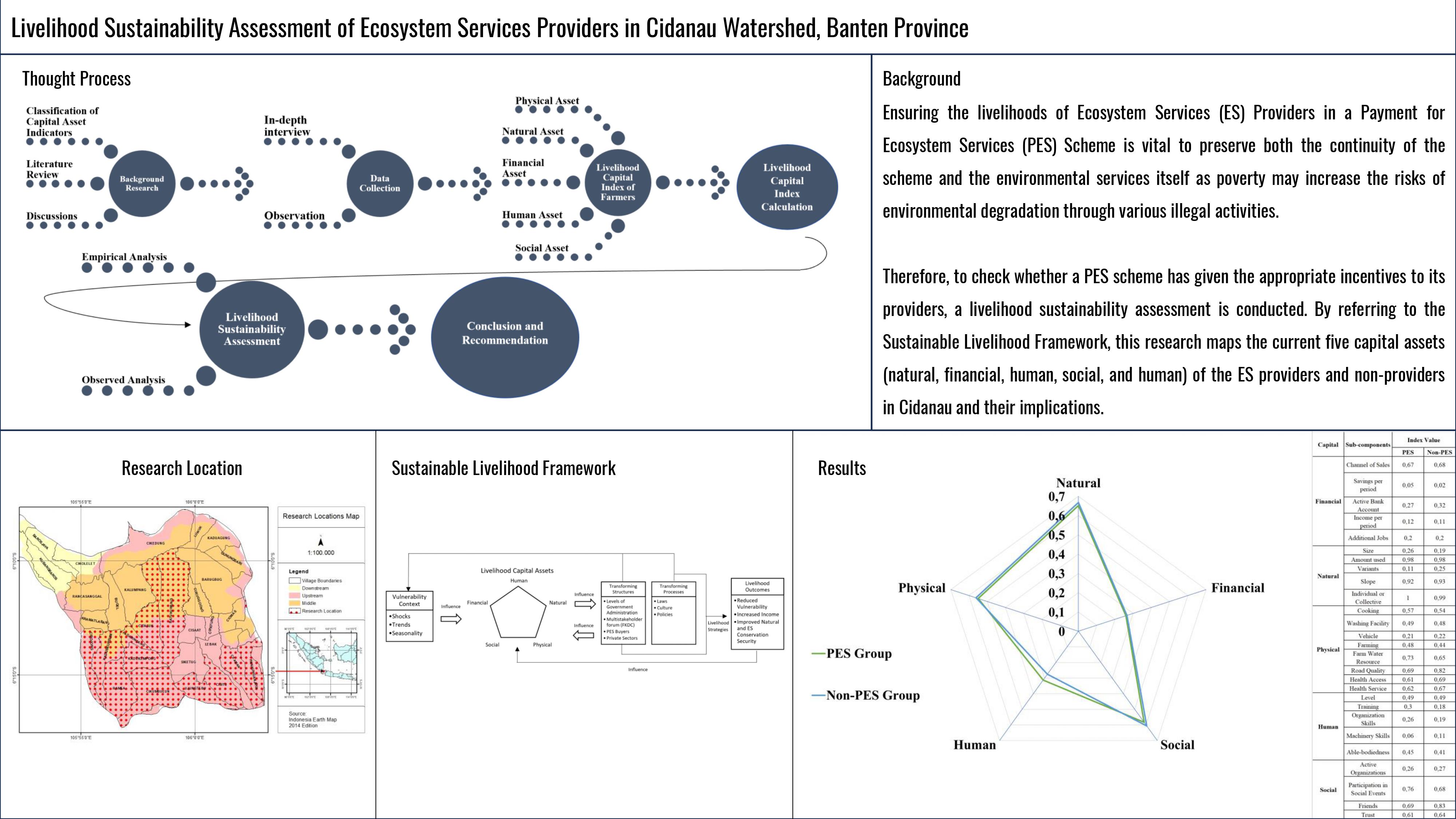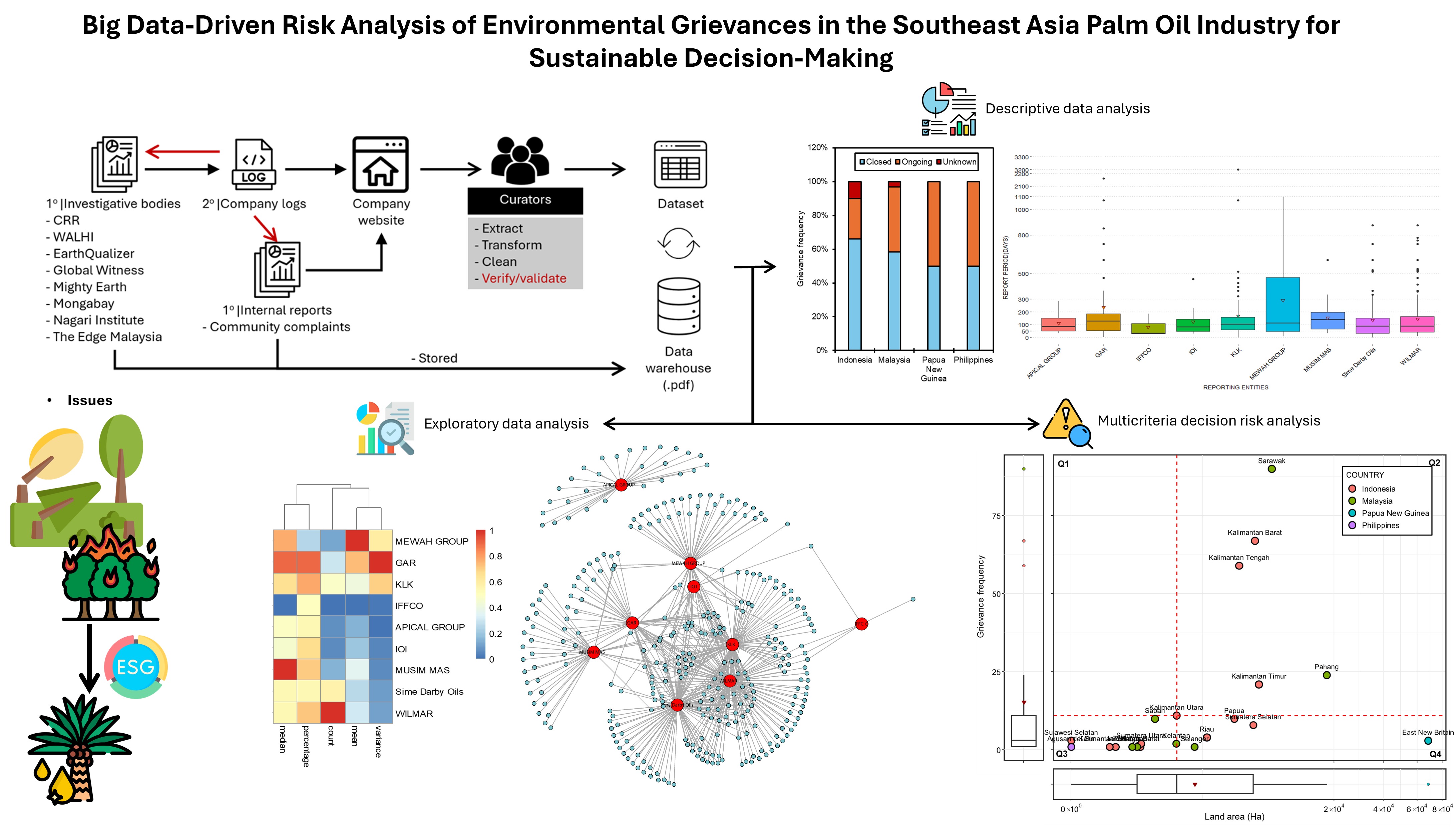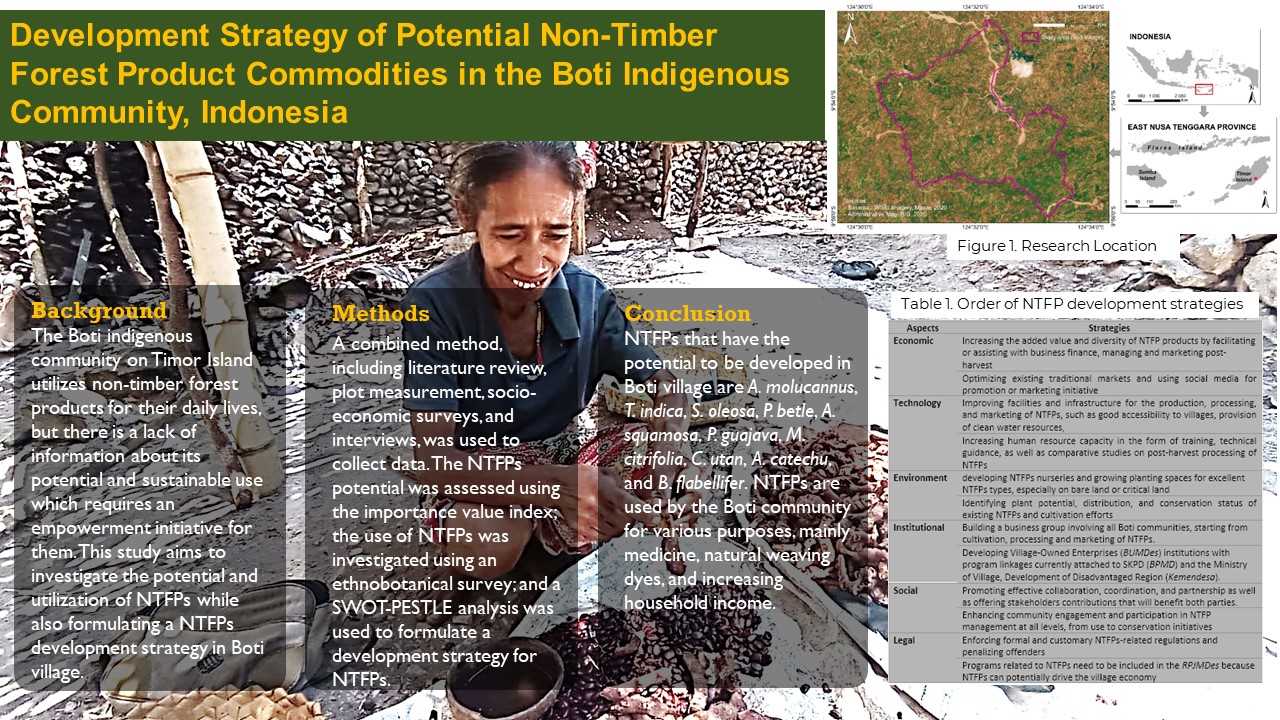Livelihood Sustainability Assessment of Payment for Ecosystem Services Providers in Cidanau Watershed, Banten Province
Abstract
The payment for ecosystem services (PES) scheme in the Cidanau Watershed, Banten Province, Indonesia has not yet quantified and reviewed its livelihood impacts on its providers after two decades of implementation. Therefore, this study maps the livelihood sustainability of PES farmers and non-PES farmers in the Cidanau Watershed using capital indexes based on the five livelihood capital assets of the DFID’s sustainable livelihood framework. The research used a quantitative method to formulate the livelihood capital indexes (LCI) as approximates to the subjects’ livelihood sustainability based on their livelihood information and draws implications from the results thereof. A total of 168 agroforestry farmers both from PES and non-PES groups were interviewed across 12 villages in the upstream area. The results show that both PES and non-PES groups share the same pattern of capital assets sustainability with the PES group having a slightly higher human capital asset. The overall LCI calculated for the PES and non-PES groups are 0.445 and 0.48, respectively. The livelihood of both groups is deemed as not yet sustainable. The farmers would have to develop their financial and human assets to attain more sustainable livelihoods and prepare themselves for adopting new types of PES in the future.
References
Amaruzaman, S., Hoan, D. T., Catacutan, D., Leimona, B., & Malesu, M. (2022). Polycentric environmental governance to achieving SDG 16: Evidence from Southeast Asia and Eastern Africa. Forests, 13(1), 68. https://doi.org/10.3390/f13010068
Amaruzaman, S., Rahadian, N. P., & Leimona, B. (2017). Role of intermediaries in the payment for environmental services scheme: Lessons learnt in the Cidanau Watershed, Indonesia. In S. Namirembe, B. Leimona, M. van Noordwijk, & P. Minang (Eds.), Co-investment in ecosystem services: Global lessons from payment and incentive schemes. Nairobi: World Agroforestry Centre (ICRAF).
Atmaja, S. (2019). Peluang mengembangkan kewirausahaan desa berbasis potensi desa. ABDIKARYA: Jurnal Pengabdian dan Pemberdayaan Masyarakat, 1(1), 48–58. https://doi.org/10.47080/abdikarya.v1i1.1043
Awazi, N. P., & Quandt, A. (2021). Livelihood resilience to environmental changes in areas of Kenya and Cameroon: A comparative analysis. Climatic Change, 165(1–2), 1–17. https://doi.org/10.1007/s10584-021-03073-5
Benjamin, E. O., & Sauer, J. (2018). The cost effectiveness of payments for ecosystem services—Smallholders and agroforestry in Africa. Land Use Policy, 71, 293–302. https://doi.org/10.1016/j.landusepol.2017.12.001
Blundo-Canto, G., Bax, V., Quintero, M., Cruz-Garcia, G. S., Groeneveld, R. A., & Perez-Marulanda, L. (2018). The different dimensions of livelihood impacts of payments for environmental services (PES) schemes: A systematic review. Ecological Economics, 149, 160–183. https://doi.org/10.1016/j.ecolecon.2018.03.011
[BPS] Badan Pusat Statistik Serang. (2023). Kabupaten Serang dalam angka 2023. Serang: Badan Pusat Statistik.
Bremer, L. L., Farley, K. A., & Lopez-Carr, D. (2014). What factors influence participation in payment for ecosystem services programs? An evaluation of Ecuador’s SocioPáramo program. Land Use Policy, 36, 122–133. https://doi.org/10.1016/j.landusepol.2013.08.002
Carloni, A. S., & Crowley, E. (2005). Rapid guide for missions. Analysing local institutions and livelihoods. Guidelines. Rome: Food and Agriculture Organization of the United Nations. https://www.fao.org/3/a0273e/a0273e00.htm#Contents
[DFID]. The Department for International Development. (1999). Sustainable livelihoods guidance sheets. London: The Departement for International Development.
[Ditjen PPI KLHK] Direktorat Jenderal Pengendalian Perubahan Iklim Kementerian Lingkungan Hidup dan Kehutanan. (2021). Updated nationally determined contribution Republic of Indonesia. Ministry of Environment and Forestry.
Duraiappah, A. K. (1998). Poverty and environmental degradation: A review and analysis of the Nexus. World Development, 26(12), 2169–2179. https://doi.org/10.1016/S0305-750X(98)00100-4
Gayen, A., Saha, S., & Pourghasemi, H. R. (2019). Soil erosion assessment using RUSLE model and its validation by FR probability model. Geocarto International, 35(15), 1750–1768. https://doi.org/10.1080/10106049.2019.1581272
Grima, N., Singh, S. J., Smetschka, B., & Ringhofer, L. (2016). Payment for ecosystem services (PES) in Latin America: Analysing the performance of 40 case studies. Ecosystem Services, 17, 24–32. https://doi.org/10.1016/j.ecoser.2015.11.010
Guo, A., Wei, Y., Zhong, F., & Wang, P. (2022). How do climate change perception and value cognition affect farmers’ sustainable livelihood capacity? An analysis based on an improved DFID sustainable livelihood framework. Sustainable Production and Consumption, 33, 636–650. https://doi.org/10.1016/j.spc.2022.08.002
Hahn, M. B., Riederer, A. M., & Foster, S. O. (2009). The livelihood vulnerability index: A pragmatic approach to assessing risks from climate variability and change–A case study in Mozambique. Global Environmental Change, 19(1), 74–88. https://doi.org/10.1016/j.gloenvcha.2008.11.002
Harbi, J., Erbaugh, J. T., Sidiq, M., Haasler, B., & Nurrochmat, D. R. (2018). Making a bridge between livelihoods and forest conservation: Lessons from non timber forest products’ utilization in South Sumatera, Indonesia. Forest Policy and Economics, 94, 1–10. https://doi.org/10.1016/j.forpol.2018.05.011
Imaniar, A., & Brata, N. T. (2020). Relasi patron-klien di antara tengkulak dan petani salak dengan dampak sosialnya di Banjarnegara. Solidarity: Journal of Education, Society and Culture, 9(1), 837–847.
Khairiah, R. N., Prasetyo, L. B., Setiawan, Y., & Kosmaryandi, N. (2016). Monitoring model of payment for environmental service (PES) implementation in Cidanau Watershed with stands density approach. Procedia Environmental Sciences, 33, 269–278. https://doi.org/10.1016/j.proenv.2016.03.078
[KLHK] Kementerian Lingkungan Hidup dan Kehutanan. (2020). Peta penutupan lahan dan batas DAS tahun 2020. Skala 1:250.000. Jakarta: Kementerian Lingkungan Hidup dan Kehutanan.
Kuang, F., Jin, J., He, R., Ning, J., & Wan, X. (2020). Farmers’ livelihood risks, livelihood assets and adaptation strategies in Rugao City, China. Journal of Environmental Management, 264, 110463. https://doi.org/10.1016/j.jenvman.2020.110463
Lan, X., Zhang, Q., Xue, H., Liang, H., Wang, B., & Wang, W. (2021). Linking sustainable livelihoods with sustainable grassland use and conservation: A case study from rural households in a semi-arid grassland area, China. Land Use Policy, 101, 105186. https://doi.org/10.1016/j.landusepol.2020.105186
Lapeyre, R., Pirard, R., & Leimona, B. (2015). Payments for environmental services in Indonesia: What if economic signals were lost in translation? Land Use Policy, 46, 283–291. https://doi.org/10.1016/j.landusepol.2015.03.004
Le Velly, G., & Dutilly, C. (2016). Evaluating payments for environmental services: Methodological challenges. PLoS ONE, 11(2), e0149374. https://doi.org/10.1371/journal.pone.0149374
Leimona, B., Pasha, R., & Rahadian, N. P. (2010). The livelihood impacts of incentive payments for watershed management in Cidanau watershed, West Java, Indonesia. In L. Tacconi, S. Mahanty, & H. Suich (Eds.), Payments for environmental services, forest conservation and climate change: Livelihoods in the REDD? (pp. 106–129). https://doi.org/10.4337/9781849806015.00011
Li, S., Juhász-Horváth, L., Harrison, P. A., Pintér, L., & Rounsevell, M. D. A. (2017). Relating farmer’s perceptions of climate change risk to adaptation behaviour in Hungary. Journal of Environmental Management, 185, 21–30. https://doi.org/10.1016/j.jenvman.2016.10.051
Liu, M., Rao, D., Yang, L., & Min, Q. (2021). Subsidy, training or material supply? The impact path of eco-compensation method on farmers’ livelihood assets. Journal of Environmental Management, 287, 112339. https://doi.org/10.1016/j.jenvman.2021.112339
Liu, Z., & Kontoleon, A. (2018). Meta-analysis of livelihood impacts of payments for environmental services programmes in developing countries. Ecological Economics, 149, 48–61. https://doi.org/10.1016/j.ecolecon.2018.02.008
Ma, J., Zhang, J., Li, L., Zeng, Z., Sun, J., Zhou, Q. (Bill), & Zhang, Y. (2018). Study on livelihood assets-based spatial differentiation of the income of natural tourism communities. Sustainability, 10(2), 353. https://doi.org/10.3390/su10020353
McGrath, F. L., Erbaugh, J. T., Leimona, B., Amaruzaman, S., Rahadian, N. P., & Carrasco, L. R. (2018). Green without envy: How social capital alleviates tensions from a payments for ecosystem services (PES) program in Indonesia. Ecology and Society, 23(4), 10. https://doi.org/10.5751/ES-10181-230410
Meijaard, E., Sheil, D., Guarigata, M. R., Nasi, R., Sunderland, T., & Putzel, L. (2011). Ecosystem services certification: Opportunities and constraints. Center for International Forestry Research (CIFOR). https://doi.org/10.17528/cifor/003500
Melvani, K., Myers, the L. B., Stacey, N., Bristow, M., Crase, B., & Moles, J. (2022). Farmers’ values for land, trees and biodiversity underlie agricultural sustainability. Land Use Policy, 117, 105688. https://doi.org/10.1016/j.landusepol.2021.105688
Mmbando, F. E., Wale, E. Z., & Baiyegunhi, L. J. S. (2017). The welfare impacts of market channel choice by smallholder farmers in Tanzania. Development in Practice, 27(7), 981–993. https://doi.org/10.1080/09614524.2017.1353066
Nasrnia, F., & Ashktorab, N. (2021). Sustainable livelihood framework-based assessment of drought resilience patterns of rural households of Bakhtegan Basin, Iran. Ecological Indicators, 128, 107817. https://doi.org/10.1016/j.ecolind.2021.107817
Nugroho, A., Amir, H., Maududy, I., & Marlina, I. (2021). Poverty eradication programs in Indonesia: Progress, challenges and reforms. Journal of Policy Modeling, 43(6), 1204–1224. https://doi.org/10.1016/j.jpolmod.2021.05.002
Nugroho, H. Y. S. H., Nurfatriani, F., Indrajaya, Y., Yuwati, T. W., Ekawati, S., Salminah, M., ..., & Baral, H. (2022). Mainstreaming ecosystem services from Indonesia’s remaining forests. Sustainability, 14(19), 12124. https://doi.org/10.3390/su141912124
Ola, O., Menapace, L., Benjamin, E., & Lang, H. (2019). Determinants of the environmental conservation and poverty alleviation objectives of payments for ecosystem services (PES) programs. Ecosystem Services, 35, 52–66. https://doi.org/10.1016/j.ecoser.2018.10.011
Olivetti, D., Mincato, R. L., Ayer, J. E. B., Silva, M. L. N., & Curi, N. (2015). Spatial and temporal modeling of water erosion in dystrophic red latosol (Oxisol) used for farming and cattle raising activities in a sub-basin in the south of minas gerais. Ciencia e Agrotecnologia, 39(1), 58–69. https://doi.org/10.1590/s1413-70542015000100007
Pham, V. T., Roongtawanreongsri, S., Ho, T. Q., & Tran, P. H. N. (2022). Impact of payments for forest environmental services on households’ livelihood: A case study in the Central Highlands of Vietnam. Environment and Development Economics, 28(2), 149–170. https://doi.org/10.1017/s1355770x22000146
Plan Vivo Foundation. (2022). Plan Vivo standard project requirements version 5.0. Plan Vivo Foundation.
Rahadian, N. (2018). Menuju pengelolaan terpadu DAS Cidanau: Peran multipihak dalam pengelolaan terpadu DAS dan penerapan konsep hulu-hilir dengan mekanisme transaksi jasa lingkungan (1st ed.). Jakarta: Perpustakaan Nasional.
Roy, T. K. (2021). Growth of agricultural labourers in West Bengal with special reference to Uttar Dinajpur District since independence. Economic Affairs, 66(1), 1–7. https://doi.org/10.46852/0424-2513.1.2021.1
Suich, H., Lugina, M., Muttaqin, M. Z., Alviya, I., & Sari, G. K. (2017). Payments for ecosystem services in Indonesia. Oryx, 51(3), 489–497. https://doi.org/10.1017/S0030605316000259
Sunaedi, N., Hadi, S. P., & Bambang, A. N. (2019a). The role of forest farmers group through payment for environmental services scheme in preserving water resources in Cidanau Watersheds at Banten, Indonesia. Proceedings of the 1st International Conference on Social Knowledge Sciences and Education (ICSKSE 2018), 91–98. https://doi.org/10.2991/icskse-18.2019.18
Sunaedi, N., Hadi, S. P., & Bambang, A. N. (2019b). Community-based environmental management through the payments for environmental services program in Cidanau Watershed, Banten Province, Indonesia. IOP Conference Series: Earth and Environmental Science, 338, 012002. https://doi.org/10.1088/1755-1315/338/1/012002
Sunaedi, N., Hadi, S. P., & Bambang, A. N. (2022). Payment for environmental services in Indonesia: Mutually beneficial watershed environmental management model. Nature Environment and Pollution Technology, 21(4), 1995–2004. https://doi.org/10.46488/NEPT.2022.v21i04.054
Tran, D. D., Huu, L. H., Hoang, L. P., Pham, T. D., & Nguyen, A. H. (2021). Sustainability of rice-based livelihoods in the upper floodplains of Vietnamese Mekong Delta: Prospects and challenges. Agricultural Water Management, 243, 106495. https://doi.org/10.1016/j.agwat.2020.106495
XE Currency. (2023). US Dollar to Indonesian Rupiah exchange rate chart: Aug 2, 2022-Aug 2, 2023. https://www.xe.com/currencycharts/?from=USD&to=IDR&view=1Y
Yamane, T. (1967). Statistics: An introductory analysis (2nd ed.). Harper and Row.
Zbinden, S., & Lee, D. R. (2005). Paying for environmental services: An analysis of participation in Costa Rica’s PSA program. World Development, 33(2 SPEC. ISS.), 255–272. https://doi.org/10.1016/j.worlddev.2004.07.012
Authors

This work is licensed under a Creative Commons Attribution 4.0 International License.
Jurnal Manajemen Hutan Tropika is an open access journal which means that all contents is freely available without charge to the user or his/her institution. Users are allowed to read, download, copy, distribute, print, search, or link to the full texts of the articles in this journal without asking prior permission from the publisher or the author. This is in accordance with the Budapest Open Access Initiative (BOAI) definition of open access.









